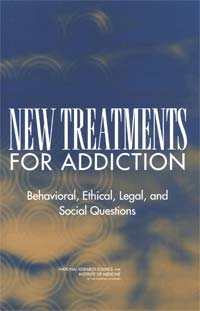Institute of Medicine Report Recommends NIDA Research Agenda for New Addiction Therapies

A mother asks a pediatrician to vaccinate her child against nicotine's pleasurable effects, practically eliminating the possibility that the child will become a smoker. A patient in treatment for heroin addiction receives an injection of sustained-release medication that will prevent her from feeling the drug's euphoric effects for a year. As current drug abuse research brings such scenarios closer to realization, NIDA has begun to study the broad implications of these and other new types of preventive treatment. These therapies underscore the need to balance therapeutic benefits and ethical considerations, particularly if the person receiving treatment—a minor child or a person involved in the criminal justice system, for example—is not the person who chooses it.
At NIDA's request, the National Research Council's Institute of Medicine (IOM) identified ethical, legal, and behavioral issues that must be considered in the development and application of active and passive immunotherapies and sustained-release medication. The Institute's 306-page report recommends a set of guiding principles as NIDA-supported research pursues the development of these potentially powerful new preventive interventions.
Immunotherapies destroy drug molecules before they reach the brain. Active immunotherapy involves a vaccine that stimulates the 's immune system to create antibodies against drugs in the same way that an inoculation creates antibodies against polio or measles virus. Passive immunotherapy involves periodic injections of antibodies rather than stimulation of the immune system; an example of this type of therapy is tetanus immune globulin, which contains antibodies to provide short-term protection for someone whose injury may have exposed them to soil-borne tetanus bacteria. Sustained-release therapies involve injection or implantation of long-acting formulations of medications that are released over a period of weeks or months to block the effect of drugs in the brain.
The IOM report identifies ways to meet the challenges these interventions are likely to pose for researchers, treatment providers, policymakers, parents, and the public. Because the treatments may have lifelong effects, IOM recommends long-term studies involving animals of different ages, as well as their offspring, before human studies are undertaken.
IOM also recommends studies that can be used to establish clear guidelines for use of the new therapies in circumstances that are inherently coercive or nonconsensual, such as in the criminal justice system, child welfare cases, or the protective immunization of minor children. What, for example, are the possible legal consequences of administering immunotherapy medications to children or adolescents? Competent adults have the right to decline medical treatment, but the legal situation is more complicated when the patient is a minor and decisions made by others on his or her behalf may have a lifelong effect. Immunotherapies will leave long-lasting biological traces that can be detected in routine blood or urine tests. Such markers could label patients as drug abusers long after they have entered sustained recovery, which could discourage some from utilizing these treatments. In its report, IOM says the development of immunotherapy and sustained-release medications highlights the need to understand addiction as a chronic medical condition that requires long-term management, a partnership between primary medical care and addiction treatment, and integration of psychosocial services into the treatment environment. The IOM report recommends that NIDA support models that integrate the new pharmacotherapies with psychosocial services in addiction treatment and primary care settings that reduce the stigma of substance abuse treatment.
The full report, New Treatments for Addiction: Behavioral, Ethical, Legal, and Social Questions, is available online at www.nap.edu/catalog/10876.html.
